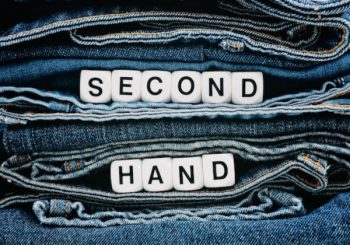By Jane Marsh
Guest Writer for Wake Up World
Many people love to buy things second-hand. In a world where fast fashion and major thrift hauls have taken over as a trend, the people who want to shop sustainably for the benefit of the planet may often not know where to turn. Sometimes, it may not be more ethical to shop second-hand. The difference lies in your household’s personal needs and what the retailer you shop at supports.
Why Should You Buy Used?
Buying used is often referenced as the most sustainable option. In many cases, it can be more beneficial for the planet to buy something second-hand than to purchase it new due to all the manufacturing that goes into creating an item.
Similarly, donating used items can lengthen their lifespans by giving them a chance with someone who needs the thing but may not be able to afford it new.
The second-hand clothing industry is worth nearly $120 billion globally, making it a sector all its own where you can pick up excellent finds for your home. Unfortunately, buying used items isn’t always a good decision. You never know at first glance whether the retailer you buy from supports sustainable practices. While it might be useful in some circumstances, it might be worth purchasing a new item in others.
Why Buying Used Might Be Counterproductive
While you might have the right intentions by shopping second-hand, you may do more harm than good. Frequenting any store means you need to research their policies and procedures, as well as how they deal with tricky situations, like taking in fast fashion brands that don’t hold up for long. Here are some things to consider when buying second-hand.
1. It Might Not Be Worth the Money
You should do your research before buying anything second-hand. Unless you know the seller, you need to ensure that they’re credible, or you may be paying more money for something with damage that you could have bought new.
Many people purchase things second-hand for the benefit of the environment, but for others, the driving force behind buying used is to save money on things that may otherwise be unaffordable.
2. You Could Be Supporting Fast Fashion
Most people know to avoid fast fashion whenever possible, but for some people, they need to buy fast fashion because it’s the most accessible. For example, if someone doesn’t have the right wardrobe for a certain job they just got hired for, they may turn to fast fashion to fill out the wardrobe they need for their workplace.
In many other cases, supporting fast fashion cannot be justified, especially when it has such horrific side effects. Buying fast fashion products means supporting systems that abuse workers by not paying them a living wage, or manufacturing that pollutes the environment.
With popular trends making people believe it’s okay for them to acquire large hauls of clothes they don’t really need or may only wear once, the world is sure to see the fashion industry contributing further to climate change.
3. The Supply Chain Isn’t Straightforward
Depending on where you donate things, your items might take a long journey before they land in thrift stores, ready to be sold. Some items are discarded immediately, which just shows that you should assess your items to make sure they won’t be tossed after donation. If your items are in poor condition, you should just toss or repurpose them yourself. Torn clothing can be used for kitchen rags or yard work.
You never know where your items are going before they land in a thrift store local to you. Some items, especially clothing, are sent to different countries overseas to be sorted, then sent back to stores close to you. If you don’t know the processes of a second-hand store, you may unintentionally support these troublesome processes that lead to more greenhouse gases or abused workers.
4. It Adds to the Clutter
Many people want to buy second-hand to help the environment, but it still won’t help that you add more clothes to your closet or items to your home.
If you really want your household to become more eco-friendly, consider downsizing your wardrobe or household items. Work with what you have. You may even choose to convert to a capsule wardrobe and find a few staple pieces that serve you well rather than a closet full of clothes you hardly wear. You may find that you get more use out of your clothes and enjoy the creativity capsules offer you.
Shop Second-Hand Smart
If you want to shop smart, consider shopping for second-hand clothing and household items that will last. You want to buy garments you can see yourself wearing multiple times rather than just once or twice for a big event or a photoshoot. You can also vow only to shop for sustainable fabrics, such as ones made of pure cotton or wool, not synthetic materials that could release microplastics.
By making small changes to your consumption routines, you can transform how you look at second-hand items and ensure you aren’t contributing to the problem.
About the author:
 Jane is the founder and editor-in-chief of Environment.co where she shares practical tips on how to live a greener life.
Jane is the founder and editor-in-chief of Environment.co where she shares practical tips on how to live a greener life.

If you've found value in our articles, we invite you to support the release of our brand-new book, "Gratitude Practices for Kids: A Practical Guide for Adults to Instill a Spirit of Appreciation and Positivity in the Next Generation."
"Gratitude Practices for Kids" brings together over 25 innovative and accessible practices designed to enhance gratitude in everyday life. This comprehensive guide is backed by 17 scientific studies, ensuring each concept is grounded in research, underscoring our commitment to nurturing growth, emotional intelligence, and positive interactions between adults and children.
We encourage you to opt for the paperback version to celebrate this new release. Dive into its fresh pages away from digital distractions, allowing you to immerse yourself in the transformative practices it offers.
Over recent years, Wake Up World has faced significant online censorship, which has impacted our financial ability to operate. Moving into book publishing represents a strategic step to secure the ongoing funds needed to continue our mission. By purchasing Gratitude for Kids, you help us keep our content free and accessible to everyone, avoiding needing a paywall. With over 8,500 articles published in the last 13 years, we remain dedicated to keeping our valuable content open to all.








